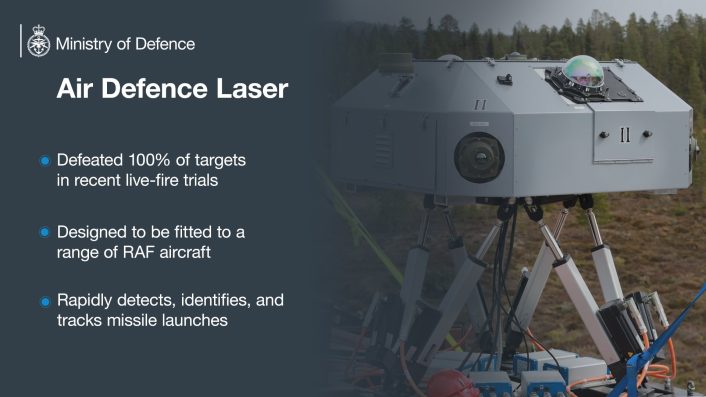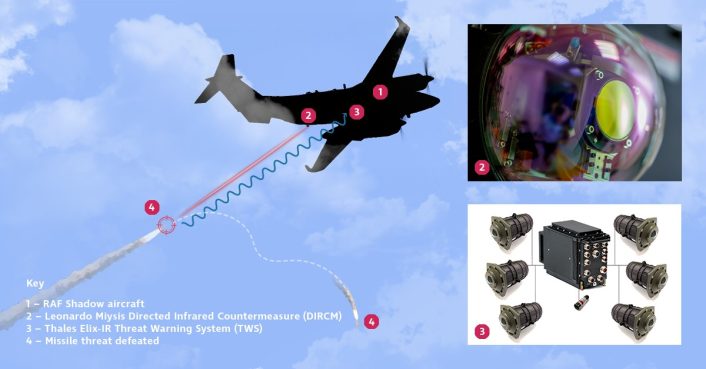During a live-fire test, the new RAF self-protection system, based on the Thales Elix-IR threat warning system and the Leonardo Miysis DIRCM, shot down 100% of the heat-seeking missiles launched against it.
The Royal Air Force’s new laser-based countermeasure, developed by a joint team from Leonardo UK, Thales UK and the Ministry of Defence’s Defence Science and Technology Laboratory (DSTL), achieved total success in its most recent live-fire test, said the MOD. The cutting-edge system will equip a range of RAF aircraft to increase the protection of pilots during combat missions.
Taking place at the Vidsel Test Range in Sweden, the trial showed how the laser system was able to defeat multiple heat seeking missiles at the same time, highlighting the extremely fast reaction time of the system as well as its high levels of accuracy.
The system consists of Thales’s Elix-IR threat warning system and the Leonardo Miysis DIRCM (Directed Infrared Countermeasure) system. Elix-IR is designed to detect the launches of Infra-red (IR) based threats such as Man Portable Air Defence Systems (MANPADS), crew based IR air defence systems, gunfire, Rocket Propelled Grenades (RPGs) and other unguided rocket fire. The system identifies the targets amongst background clutter and tasks a suitable defensive countermeasure to neutralise the threat.
In this instance, the countermeasure selected is the Miysis DIRCM. This countermeasure tracks the incoming IR missile and directs a jamming laser into the IR seeker built into the missile, which causes the missile to swerve away and miss its intended target.
According to the MOD, threats are detected and “defeated faster than the time it takes to read this sentence”, showcasing the high levels of confidence they have with the system. “This UK engineered capability gives the MOD the latest generation best-in-class protection, whilst enjoying full operational independence, and offering the same freedoms to export customers,” says the press release.
With the total success of this test, the combination of Elix-IR and Miysis is set to be introduced as a passive defensive countermeasure onto a number of RAF aircraft. These include the A400M Atlas C.1 medium transport aircraft as well the Shadow R2 Intelligence, Surveillance, Target Acquisition and Reconnaissance (ISTAR) aircraft.

Reactions from Officials
This live fire test was conducted with the presence of multiple officials from fellow NATO nations, industry officials and MOD personnel. The presence of NATO personnel highlights the broader applications for the system as, despite being a sovereign UK capability at the moment, there is clear interest from allied nations in similar systems.
Secretary of State for Defence John Healey stated that “identifying, tracking and defeating threats from the air in seconds is crucial to having the edge over those who try to do us harm.” He also keenly highlighted the important and growing relationship the UK Armed Forces have with the industry, stating that “this high-tech laser is another excellent example of joint working between our Dstl experts and the UK’s defence industry.”
Research and development within the British defence sector goes a long way towards making Britain a world leader in certain military capabilities, allowing British forces to do their jobs whilst also opening export markets for certain technologies.
DSTL’s chief for air survivability stated that “the UK defensive aids system is the culmination of MOD’s detailed understanding of changing threats alongside years of sustained defence investment in science and technology nurtured within Dstl.” It was only through the channelling of defence industry partners DSTL, Leonardo UK and Thales UK that the test could have been so successful.

The need for improved self-protection
MANPADS and short-range IR guided air defence missiles are a large threat for low flying transport aircraft like the Atlas, with landings and takeoffs being particularly dangerous, especially when operating in austere conditions. The RAF’s Shadow R2 faces similar threats with regards to low flying as the need to overfly hostile areas in order to conduct the ISTAR role leaves it similarly at risk from short range air defence systems.
The lessons learned from conflicts over the past 40 years demonstrated the need to protect aircraft from this kind of threat. The adoption of this new laser-based system will grant RAF aircraft a distinct advantage when conducting low flying in hostile air environments in the near future, giving aircrew an extra layer of very needed protection.
Historically, during the war in Afghanistan, International Security Assistance Force (ISAF) military aircraft of all types would occasionally deploy flares when taking off or landing at Kandahar and Kabul airports due to the knowledge that the Taliban possessed a limited supply of FIM-92 Stinger MANPADS. Despite there being no instances of aircraft shot down due to a MANPADS in Afghanistan, Coalition aircrew took the threat seriously enough to test their defensive suites often in case they were required.
However, with MANPADS becoming more sophisticated, flares, the traditional countermeasures used against these threats, are becoming less and less effective. The inclusion of the new laser-based self-protection system on future aircraft will instil aircrew with an added sense of security when operating in conditions such as they were in Afghanistan, as well as future high-intensity conflict scenarios.
Why DIRCM?
DIRCM is being adopted by more nations due to the introduction of more advanced MANPADS which are able to detect fainter IR signals, rendering the use of flares as a countermeasure unreliable in some circumstances. Rotary and fixed-wing aircraft face considerable threats from IR-based air defence missiles and will need modern countermeasures to ensure that the RAF and its allies do not face losses from this threat in the future.
DIRCM such as Miysis offers the RAF far better protection than reliance on only flares for IR missile defence, with this test proving that, once the DIRCM is integrated with a detection system such as Elix-IR, the threatened aircraft has a far better chance at escaping unharmed.

The RAF’s work on new self-protection systems
In 2016, Leonardo supported a UK MoD sponsored live-fire activity to demonstrate a similar complete, operationally representative, UK NDAS-compatible (NATO Defensive Aids System) Electronic Warfare (EW) System. The system, integrated into a pod supplied by Terma, featured the Elix-IR MWS, Miysis DIRCM and EW Controller, an N-DAS/SCI-260 compatible architecture and an operationally representative test jamming waveform developed by the DSTL.
In October 2018, Leonardo and Thales have announced that the combined Miysis and Elix-IR missile warning and protection system has been proven highly effective during live-fire scenarios as part of SALT III hosted by FMV at Vidsel. The two systems, integrated through Leonardo’s DAS Controller aboard a Terma Universal DIRCM pod, demonstrated the capability to quickly defend against incoming IR-guided surface-to-air missiles thanks to the optimised “threat-warning/threat-defeat chain“.
In September 2019, the UK MoD contracted Leonardo and Thales to deliver an integrated UK Defensive Aids System that will equip the RAF’s fleet of eight Shadow ISTAR aircraft. The aircraft, which are based on the King Air 350CER and operated by 14 Squadron out of RAF Waddington, are undergoing major upgrades with Initial Operating Capability targeted for this year. The complete system features the Thales Elix-IR Threat Warner, Leonardo DAS Controller, Leonardo Miysis DIRCM and Thales Vicon Countermeasures Dispensing System.
#Miysis DIRCM uses open architecture to allow incorporation of Missile Approach Warners. Learn more at #ADEX2017 https://t.co/9gaGRoV8CP pic.twitter.com/FKWx7QLYuP
— Leonardo (@Leonardo_live) October 19, 2017
What is Miysis?
Miysis is a low-power-draw, low-weight DIRCM designed to provide high-power, all-aspect protection against modern and legacy threats. Miysis features a twin-head laser pointer/tracker system as a single head DIRCM does not provide the necessary level of spherical protection to defeat more advanced threats. In fact, the airframe would mask some angles and create shadow zones where the DIRCM would not be able to “see” the threat, putting the aircraft at risk. The company says that a three-head system is also available for coverage on large platforms with high-value missions.
The development of Miysis capitalised heavily on key IR sensor, laser and sightline control technologies made available from Leonardo’s internal advanced technology investments, combined with the latest open-architecture system concepts and MOTS/COTS (Military Off-The-Shelf/Commercial Off-The-Shelf) hardware. The open architecture design readily supports the integration of Miysis on any aircraft, either as a stand-alone DIRCM solution or as part of a broader Defensive Aids Suite (DAS), as well as allowing a quick integration with the accompanying Missile Warning System.
Leonardo believes that the Miysis DIRCM System is currently the smallest and lightest high Energy-on-Target, multi-turret, full DIRCM system available to the world market today, with a total system weight of less than 40 kg (excluding the MWS). It has a peak power draw of less than 1300W, and typically draws less than 600W during jamming with both heads, giving it the lowest aircraft power requirements of any comparable system.
The functioning mechanism can be explained as follows: when a missile is launched, the MWS sensors detect the IR-signature of its rocket motor. The control unit then cues the DIRCM to the detected IR-track, quickly examining it to determine if it presents a threat to the aircraft. If the track is recognized as an immediate danger, the DIRCM begins the jamming action directing its laser energy on the missile’s seeker, disturbing its guidance as needed to protect the aircraft.
The baseline Miysis DIRCM System comprises two integrated Laser Pointer/Trackers, a Single ruggedised COTS Control Electronics Unit and a Cockpit Interface Unit, and can be either installed directly in the airframe or in an external pod. The system as described is then integrated with a separate DIRCM-capable MWS, which is chosen by the customers according to their requirements. Miysis has already been tested with six different MWS systems, whose quick integration has been significantly simplified thanks to open architecture interfaces.
You can read more about Leonardo’s Miysis DIRCM in this detailed report we published here at The Aviationist.









